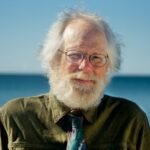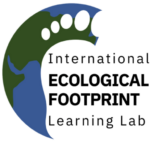
By Bart Hawkins Kreps
IEFLL Research Fellow
Master Student at York University
December 2024

By Anna Stratton
IEFLL Research Fellow
Master Student at York University
December 2024
“We are killing ourselves and our planet and no one seems to want to face the truth,” says Calgary planning analyst Les Kuzyk. Yet he continues his work, making significant contributions to Ecological Footprint science while documenting what he says is Calgary’s “7 planet lifestyle.”
Les began his career by earning a Petroleum Technology diploma and working in the fossil fuel industry – and that work convinced him he wanted to work on environmental issues. After obtaining further diplomas in Photogrammetry and GIS he began work as a Policy Analyst for the City of Calgary, where he has been for the past 30 years.
Working on his own time he has also delved deeply into the Ecological Footprint framework. He has presented his findings in annual reports, presentations and policy papers.
About ten years ago, with data from the Ecological Footprint accounts and Statistics Canada, Les presented a paper to city council that indicated that the easiest way to determine carbon footprint levels in the community was by income levels – the higher the income level, the higher the footprint. Income is a “solid proxy” for carbon emissions. However, the response was that that information was too sensitive to circulate.
More recently his 2023 paper “Census villages and the ecological footprint”, published in Ecological Indicators, offered a method of integrating detailed municipal data with national-level Ecological Footprint accounts. As a result he was able to estimate neighbourhood-level carbon emissions from vehicles and from residential electricity use. The calculations incorporated data on number, age and rated fuel efficiency of registered vehicles, mode share of personal travel, average house sizes, and the ages of houses. The overall results pegged the mean Calgary lifestyle as requiring 7.4 planets, with some neighbourhoods at a 10-planet Footprint.
By contrast, several communities in the nearby Kootenaay region of British Columbia had a mean footprint of 3.3 planets. Much of the difference could be attributed to a cleaner source of electricity – in BC, 90% of the electricity was hydro-electric, while Alberta still relied on fossil fuel-fired generation. The other major factor differentiating the Kootenays from the Calgary Region remains median household income.
Communicating this information to people who can enact policy changes has been difficult and frustrating. Les likes the Global Footprint Network use of the “number-of-planets” metric, but he suggests that the GFN “overshoot day” metric is not well understood. He adds that the ‘global hectares’ measurement of the ecological footprint and biocapacity accounts is useful for people working in the field, but not “graspable” by non-specialists or by councillors or staff at the city level.
The City of Calgary created a Climate Action Plan which was updated in 2020. The Plan includes carbon reduction targets, but to date “there has been little progress” in achieving the targets. Les has reported information from the ecological footprint analysis of Calgary’s increasing use of biocapacity, but he feels that there is little understanding of it, and he has tried with several sets of councils and administrations.
He was briefly optimistic about a change at the city level when in 2021 the new mayor declared that her first order of business would be to declare a climate emergency in the city. But, according to Les, there has been no movement, although the city appears to be working on its corporate plan to reduce emissions in city government’s own operations and buildings. He suggests that perhaps working on corporate emissions is a more “graspable” task than the larger and more daunting task of tackling the larger community emissions issues.
In his efforts he draws inspiration from others both locally and internationally. One of these allies is Joe Vipond, an emergency physician in Calgary and a founder of the Calgary Climate Hub which advocated for specific measures for the City’s climate action, stating that “If we fail, the planet fails, and the thing that’s important now is speed, winning slowly is the same as losing.” He has joined with UK climate activists Rupert Read, a professor of philosophy, and Jem Bendell, a professor of sustainability and founder of the Deep Adaptation Forum. He is also inspired by the work of Johan Rockström, a Swedish scientist recognized for his pioneering work on the nine planetary boundaries framework for maintaining a safe operating space for humanity.
Finally, he feels that there is hope in us learning from indigenous leaders and he has turned to teachings from leader Robin Louis of the Ktunaxa (pronounced ‘k-too-nah-ha’) nation in southeastern British Columbia. Les points out that in BC 94% of the land is unceded and that indigenous peoples are actively talking to the government about rights to their land. “They took care of the lands and waters for thousands and thousands of years and have lived through 200 years of chaos and destruction and have survived and still have hope – what can we learn from them about how to manage the planet?”
The need for change is urgent and time does not wait for us. Les points to a recent report for the IPCC that indicates that the target of limiting carbon emissions to 1.5 degrees will only happen if we reduce our emissions by 50% by 2030. He points out that during the Covid pandemic, and following the financial crisis of 2008, the world reduced its emissions by something like 5%. Rather than learning from these opportunities, Les says, we have returned to business as normal.
But he knows he must keep pursuing answers for his teenaged daughter and future generations – he’s not giving up.